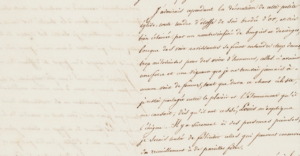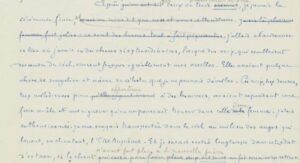On Page 34 of Volume 1 of the Historique, the six-volume narrative section of theVoyage autour du Monde, Louis de Freycinet described his experience of a church service in Rio de Janeiro. Critical as he was of almost all aspects of the attitude to religion displayed by the inhabitants of the city, he was impressed by the singing. Even there, however, he had his reservations. He wrote:
J’admirois cependant la décoration de cette petite église, toute tendue d’étoffe de soie brochée d’or, et très-bien éclairée par un nombre infini de bougies et de cierges, lorsque des voix ravissantes se firent entendre : trop douces, trop claires pour des voix d’hommes, celles-ci avoient une force et un ton grave qu’on ne trouve jamais à aucune voix de femme….. Ainsi donc, au Brésil comme en Italie , le luxe de la musique porte les Portugais à faire usage de ces êtres mutilés que la nature désavoue, tristes et déplorables victimes de la sensualité et de la barbarie des hommes! Il y a surement ici des personnes pieuses ; je serois tenté de féliciter celles qui peuvent conserver du recueillement à de pareilles fêtes.
His wife Rose attended the same ceremony, and in a letter to her mother, the fifth in the series of manuscript copies that have survived to the present day, she wrote:
J’admirais cependant la décoration de cette petite église, toute tendue d’étoffe de soie brochée d’or, et très bien éclairée par un nombre infini de bougies et de cierges, lorsque des voix ravissantes se firent entendues: trop douces, trop mélodieuses pour des voix d’hommes, celles-ci avaient une force et une vigueur que je ne trouvai jamais à aucune voix de femme; tant que dura ce chant céleste, je restai partagée entre le plaisir et l’étonnement qu’il me causait; dès qu’il eut cessé, Louis m’expliqua l’énigme…… Il y a sûrement ici des personnes pieuses; je serais tentée de féliciter celles qui peuvent conserver du recueillement à de pareilles fêtes.

Figure 1. Extract from the copy of Rose de Freycinet’s Letter 5 to her mother, sent from Rio de Janeiro. As was the case with all the copies, only half the page was used, presumably in order to leave space for comments, although these were rare. The row of dots in the third line from the bottom, after ‘l’énigme’, may indicate the omission of some of the text in the original letter. Comparison with Figure 2 shows that the writer was not Charles Duplomb, one of the editors of the 1927 publication of Rose’s journal, although the copy might have been made for him.
Except for one (underlined) sentence in each, these accounts can be matched sentence for sentence. It cannot be doubted that one of the authors copied from the other, and while in this instance it might merely be suspected that it was Louis who copied from Rose, there is definite proof of this in some of the many other examples. The omission by Louis of the underlined sentence in Rose’s account is easily explained. It could not be included in the Historique because it revealed her presence, and she was not supposed to be there.
The status of the sentence that appears only in the Historique is less certain, but as the translation below of Rose’s version shows, it makes perfect sense if it is inserted at the point where, in the extract shown in Figure 1, there is a row of dots.
However, while I was admiring the decoration of this little church, all hung with silk fabric embroidered with gold, and very well lit by an infinite number of candles and tapers, ravishing voices were heard: too soft, too melodious to be the voices of men, they had a strength and vigour that I have never found in the voice of any woman. As long as this heavenly singing lasted, I remained torn between the pleasure and the astonishment that it caused me, but as soon as it had ceased, Louis explained the puzzle to me. So, in Brazil as in Italy, the love of fine music leads the Portuguese to make use of these mutilated beings, whom nature abhors and who are the sad and pitiable victims of the sensuality and barbarity of man. There must surely be pious people here. I would be tempted to congratulate those who can continue to focus their thoughts on the spiritual at such celebrations.
The sentence from the Historique is underlined. In her journal Rose recorded a similar reaction “The reply presented to my mind a cruelty that I had never been able to imagine until that day” (la réponse retraça dans mon esprit une cruauté que je n’avais jamais pu concevoir jusqu’à ce jour). The person who wrote such a sentence could very easily be the same person as wrote the sentence in the Historique.
This comparison would be only mildly interesting were it not for the way in which it highlights one of the outstanding problems with Rose’s letters to her mother. As far can be ascertained, these exist today only in the form of manuscript copies, and these were used in the 1927 publication of her journal to fill the gap in the diary that extends from the departure from Timor to shortly after the arrival in Sydney. They were, however, treated by the journal’s editors, Charles Duplomb, a naval historian, and Henri-Paul de Freycinet, the great-nephew of Louis de Freycinet, who became the third Baron de Freycinet in 1881, in a rather surprising way. The manuscript of the journal was edited extensively, one might almost say brutally, before it was considered fit for publication, but in editing of the letters, if they are faithful copies of the original, their touch was very light indeed and omissions were few. This would be explicable were these copies versions of original texts that had already been edited severely enough to render them acceptable to those editors with little modification. It is therefore important to establish when, why and by whom they were made.
There are four realistic possibilities, or hypotheses.
1. By or for Louis de Freycinet in the 1820s, when he was making use of Rose’s account of the Uranie voyage in writing the Historique.
2. By or for Louis de Freycinet after Rose’s death in 1832, at a time when he was thinking of preparing them for publication. In support of this possibility there is a footnote by Jean de la Roquette in his “Notices historique sur MM. Henri et Louis de Freycinet”, published in 1843 in the Bulletin de la Société de géographie. In it he said that Rose had “described the impressions that so many new objects made on her, in letters written to her family which her husband has, it is said, collected to perhaps publish one day, and which we have not been able to procure; we only know that she conveys those impressions in the most striking manner”.
3. By or for Louis René (Lodoix), the second Baron de Freycinet, after Louis’s death in 1842, in possible preparation for an ‘In Memoriam’ of Rose, who was not only his aunt but had cared for him in Paris for three years whilst his parents were living on Réunion.
4. By or for Henri-Paul in the 1920s, as fair copies of his own edited version of the letters.
Two of these possibilities have to be considered improbable. A major objection to the first, which seems attractive at first sight, is that, in contrast to the Historique, in the copies the reformed spelling (e.g. ‘avait’ instead of ‘avoit’ and ‘enfants’ instead of ‘enfans’) is used, and this only became the standard in 1835. As far as the third hypothesis is concerned, there is no evidence that Lodoix, who died in 1877 and was the custodian, as the Baron de Freycinet, of the family archives for thirty-seven years, ever showed any interest in such things. He was at sea for much of his life.
There remain Hypotheses 2 and 4. While Hypothesis 2 is now generally accepted, it is not yet possible to rule out Henri-Paul. If the original letters were available to him, transcripts would certainly have had to be made for any editing to be done, as was done by Chrles Duplomb for the journal (Figure 2), and If the copies that we have are fair copies of edited versions, this would explain why the published text follows them so closely.

Figure 2. Extract from Charles Duplomb’s working transcript of Rose de Freycinet’s journal, covering a part of the church visit in Rio de Janeiro.By his standards, this section has been quite lightly edited.
An obvious objection is that even the early letters, for which the journal was also available and was used in the publication, were copied. It is, however, possible that at the start of the project the editors were unsure of how to combine their two sources, and only later decided to prioritise the journal, and it might have been only after the letters had served their primary purpose, of filling the Timor to Sydney lacuna, that the decision was made to ignore the letters elsewhere. After that decision had been made, there would have been much less incentive to continue transcribing them. This would explain why the period covered by the copies ends with the letter written just beyond the point at which the journal could again be used. It is unlikely that this was the last letter received by Rose’s mother, since we know Rose sent her a letter from the Falklands which is very likely to have arrived. The letter to Louis’ parents, sent at the same time by the same means, did do so.
If the original letters were, in fact, available to Henri-Paul in the 1920s, it would be difficult to account for their having since disappeared. While it is almost equally hard to imagine why the copies, but not the originals, would have survived if both were in the possession of the Freycinet family in the1830s, there was one person outside the Freycinet family who might have claimed the originals as of right after Rose’s death, and that was her sister Stéphanie. Her claim to these mementoes of both her mother and her sisrer might even have been the reason for the copies being made.
On balance, and even though it is difficult to imagine the very pernickety 20th century editors of the 1927 edition leaving a 19th century editing almost untouched, the currently accepted 1830s origin for the copies seems most likely to be the correct one. It would, however, be useful for it to be confirmed, if it has not already been done, that the inks and paper used are compatible with such an origin.
